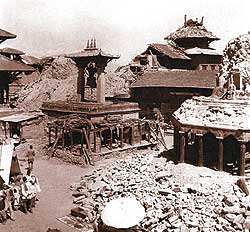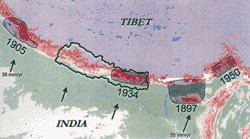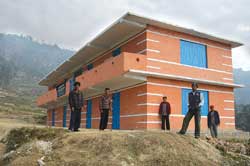 It was sunny winter afternoon, bright blue sky and a slight breeze from the west. Most families in Kathmandu were on their roof terraces, or in the fields. Suddenly, birds took flight, dogs started howling, there was a deep underground rumble, fields started undulating like waves on the ocean, houses crumbled, long fissures appeared on the roads and a great pall of dust rose over the city.
It was sunny winter afternoon, bright blue sky and a slight breeze from the west. Most families in Kathmandu were on their roof terraces, or in the fields. Suddenly, birds took flight, dogs started howling, there was a deep underground rumble, fields started undulating like waves on the ocean, houses crumbled, long fissures appeared on the roads and a great pall of dust rose over the city.
Within a minute, 17,000 people were dead in Nepal and northern Bihar, many of them in Kathmandu Valley. Among the dead were two of King Tribhuban's daughters and a daughter of Juddha Shumshere. Most houses were destroyed or damaged. This 8.0 magnitude earthquake with its epicentre along the Nepal-Bihar faultline snaps every 75 years. Aftershocks kept coming for two weeks, and the survivors camped out in the freezing cold.
What is frightening to many is not the memory of that fateful day 70 years ago. What will happen the next time an earthquake of that magnitude hits Kathmandu is the real concern. And many were reminded just how bad it could be when they watched the devastation of the Iranian city of Bam last month, where 50,000 people were killed.
Given Kathmandu's rampant growth and flimsy housing, the next big one will kill at least 100,000 people. Those who die may be the lucky ones.  They say earthquakes don't kill people, houses do. But try telling that to the private home owners adding another floor to their fragile houses, or bribing an official to pass a house design so they can save money on construction. Most of us are acting like an ostriches with heads in the sand when it comes to preparing for the next big one.
They say earthquakes don't kill people, houses do. But try telling that to the private home owners adding another floor to their fragile houses, or bribing an official to pass a house design so they can save money on construction. Most of us are acting like an ostriches with heads in the sand when it comes to preparing for the next big one.
Out of the 21 cities around the world that lie in seismic zones, Kathmandu is at the highest risk of death, destruction, and unpreparedness. Matters are not helped by the city's extremely high urban density: Kathmandu has an uncontrolled urban development with a 6.5 percent annual growth rate. The population hovers around two million and some 6,000 concrete houses are built every year, usually without proper engineering. It is not hard to imagine what will happen on a 8.0 magnitude earthquake. This city will collapse like a deck of cards when (not if) the next big one hits.
1934 wasn't even the worst earthquake Kathmandu has suffered. In 1255, one-third of the population of Kathmandu (30,000 people, including King Abhaya Malla) were killed when the valley suffered a direct hit with an epicentre right below the city. The effect of such a strong earthquake would be colossal.
Luckily, there are some who have seen the writing on the wall, and are working on ensuring that a maximum number of people are aware of the dangers. The first thing is to know what to do in an earthquake, what a community needs to do to prepare, how not to build houses, and when the big one does strike what can be done to care for the survivors.  "A massive awareness program is needed as our goal is to turn Nepal into a totally earthquake safe community by 2020," says Ramesh Guragain, a structural engineer. Indeed, a partnership between Nepali quake safety groups, the government and international organisations has resulted in a higher level of awareness about the dangers, now all that needs to be done is to put some of the disaster preparedness ideas into practice.
"A massive awareness program is needed as our goal is to turn Nepal into a totally earthquake safe community by 2020," says Ramesh Guragain, a structural engineer. Indeed, a partnership between Nepali quake safety groups, the government and international organisations has resulted in a higher level of awareness about the dangers, now all that needs to be done is to put some of the disaster preparedness ideas into practice.
Historical records show that Kathmandu has been hit by a major 1934-type earthquake every 75 years. So, the next one is due, literally, any day now. But experts have discovered that there is even greater danger of a big earthquake in central Nepal, as a 'seismic gap' where tectonic energy has not been released for more than 200 years and a massive earthquake could strike at any time. This puts the lake town of Pokhara as well as other major western towns at risk not just from building collapse, but also from glacial lake outbursts along snowfed rivers.
"The next one will be more lethal and can arrive at anytime," says Amod M Dixit of the National Society for Earthquake Technology (NSET).  While forecasting an earthquake is imprecise and nothing can stop geological upheavals, experts are concerned by the lack of disaster preparedness here. "Nepal would be in a situation worse than what happened recently in Bam," says Dixit of the 26 December earthquake in the ancient Iranian city.
While forecasting an earthquake is imprecise and nothing can stop geological upheavals, experts are concerned by the lack of disaster preparedness here. "Nepal would be in a situation worse than what happened recently in Bam," says Dixit of the 26 December earthquake in the ancient Iranian city.
He worries about the lack of awareness among the people and the government's passive attitude towards the issue. "The 1998 earthquake changed my whole life because it taught me that people died when information was limited only to seismologists and geologists," says Dixit. That 7.3 magnitude quake in eastern Nepal left 721 dead and 6,553 injured.
Inevitably, earthquake experts face allegations that they are unnecessarily scaring the public and crying wolf. But it is certain that without proper planning, the number of those who are killed in a future earthquake will be much higher. Disaster preparedness specialists say it is better to worry now and be prepared, than to wait for the quake to strike and then panic.  "We need to spread the message across the country starting right now," says Ramesh Aryal, chief of the Earthquake Division at the Department of Mines and Geology. "This is where the government should also work actively to try to form disaster committees in every ward."
"We need to spread the message across the country starting right now," says Ramesh Aryal, chief of the Earthquake Division at the Department of Mines and Geology. "This is where the government should also work actively to try to form disaster committees in every ward."
The United Nations has also been trying to prod the government into preparedness by addressing mitigation and prevention. They want building codes helped draw up in 1994. "A strong enforcement of the code is needed, it is the best way to ensure safer housing," says MB Thapa, a disaster program adviser at UNDP.
The only silver lining so far has been initiative taken by local government bodies. When Lalitpur municipality implemented the building code last year, it was the only one in the world to take such a precaution before the occurrence of an earthquake. Now Bhaktapur has followed suit, and earthquake experts hope that Kathmandu's Mayor Keshab Sthapit will also take the initiative. "Such an effort reduces at least three-fourth of the risk from earthquake hazard," says Dixit.
Nepal's biggest temblors
1255
One-third of Kathmandu's population of 100,000 was killed, inlcuding King Abhaya Malla.
1408
Many of Kathmandu's temples and houses were destroyed, including the shrine of Machindranath. Thousands were killed.
1681
Many houses collapsed, hundreds were killed in this quake during the reign of Srinibas Malla.
1767
There was a swarm of tremors (21 shocks in 24 hours) in this Asar Ek quake in Kathmandu.
1808 or 1810
Year not confirmed, but this violent quake destroyed many houses in Bhaktapur. Temples in Kathmandu remained unscathed.
1823
Another swarm of quakes in Kathmandu with 17 tremors in one day.
26 August 1833
Epicentre near Phaplu, this 7.7 magnitude quake killed more than 500 people. It rocked Kathmandu and was even felt in Delhi and Kolkata.
23 May 1866
7.0 magnitude quake with epicenter north of Kathmandu rocked the valley. No major damage.
28 August 1916
7.1 magnitude earthquake, epicenter near Mt Api in western Nepal. Damage in Darchula and Indian Kumaon.
15 January 1934
The Big One. 8.0 magnitude quake with epicenter in Bihar-Nepal border. Nearly 17,000 people killed, 4,500 in Kathmandu Valley. Tremors felt as far away as Mumbai.
27 May 1936
7.0 magnitude quake near Dhaulagiri in central Nepal.
4 September 1954
Pokhara rocked by 6.5 magnitude quake.
11 January 1962
6.0 magnitude tremor epicenter same as 1934 quake.
26 September 1964
6.2 magnitude, epicenter in Darchula.
12 January 1965
6.1 tremor with epicenter northeast of Dhankuta.
27 June 1966
Another 6.0 magnitude tremor in Darchula.
29 July 1980
6.8 magnitude epicenter in Darchula, 150-200 people killed. Felt in Kathmandu
21 August 1988
6.8 magnitude epicenter in Udaipur, killed 900 in Nepal, Bihar. Damage reported in Sikkim. Felt in New Delhi.
9 December 1991
Epicentre in Bajura, 6.2 magnitude.
No reports of deaths.
Better safe .than sorry Like most other parts of Kathmandu Valley, the village of Chaling outside Bhaktapur is also seeing a housing boom.
Like most other parts of Kathmandu Valley, the village of Chaling outside Bhaktapur is also seeing a housing boom.
But look carefully, and a visitor notices a big difference. These aren't haphazard flimsy construction. Masons like 28-year-old Biswa Ram Tyaka and five of his colleagues have just finished rebuilding the Nateswari Primary School (see pic) to make it earthquake resistant with personal donations from villagers.
They have all been trained at the National Society for Earthquake Technology (NSET) in masonry work that will survive a major earthquake without serious damage. The six have already convinced locals that it is prudent to invest in earthquake resistant houses. These days, if anyone wants to build a house in Chaling and its surrounding villages, they go straight to Tyaka and ask for advice.
While it has been relatively easy to convince Chaling to follow the earthquake safety building code plan, experts face an uphill challenge doing the same in core urban areas of Kathmandu and other major cities. Earthquake Safety Day on 16 January will commemorate the 70th anniversary of the 1934 earthquake. It's as good a time as any to prepare for the next big one.
If Chaling's example can be replicated, maybe the rest of Kathmandu Valley and Nepal will be a safer place the next time an earthquake strikes.
An 8 magnitude earthquake in Kathmandu Valley is like nuclear war. Most of us don't want to think about it.
"I know it sounds scary but we are living under extremely vulnerable circumstances. The magnitude of destruction will be unimaginable," says Gyan Jung Thapa, national security officer at UNDP. Things could be worse, but they could also be better if we are prepared. Start now.
The job of most earthquake experts is to think of the worst-case scenario and plan for it. As things are now, what will happen to Kathmandu in the next major earthquake of 8 magnitude or above?
. 60 percent of the valley's buildings will collapse. If it happens at night when people are sleeping, as many as 125,000 people may be killed.
. Anything more than two storeys high will either collapse or sustain severe damage.
. Rockfalls and landslides will block all main highways leading into Kathmandu, the airport will be unserviceable so international relief will have to be parachute dropped, which will take at least four days to arrive.
. Most open spaces have disappeared, including most of Tundikhel which was where most people camped out in 1934. People will have to spend weeks outdoors along parks, roads or river banks.
. Water will be scarce. The mains, such as they are, will not work. The ground water table will recede, so most wells will go dry.
v There is high risk of fires caused by explosions of gas cylinders, kerosene stoves and gas stations in the centre of the city.
. Electricity and telephone lines will be cut off.
. If the earthquake happens during the monsoon, liquefaction will mean that the city will be floating as the soil turns to paste. Water borne diseases, exacerbated by rotting corpses, will grow into an epidemic that will kill many initial survivors.
. The hospitals left standing will be understaffed and overwhelmed with the wounded.
. No one has even started thinking about the social anarchy, looting, crime in the absence of a strong security resence.
Rembering Nabbe Sal Amina Banu, 76
Amina Banu, 76
My family used to be in the Muslim traditional cloth businessmen in Indra Chowk. I was six, my 10-year-old sister and I were playing on the roof that afternoon. Suddenly everything started shaking. The top floor of the house was completely destroyed. The staircase collapsed, but my elder brother managed to bring us down. We lived in the garden for 15 days, we didn't have enough to eat. Other Muslim families helped us and gave us food.  Ram Chandra Lal Joshi, 90
Ram Chandra Lal Joshi, 90
Businessman
We were a small family: just my sister, my father and myself. I was in the shop when it happened. Tulsi dai dragged me out, the electric wires were sparking, the buildings were swaying wildly. When the shaking stopped, we rushed home. My sister was sitting by the stupa, then my father joined us. Everyone else was safe, but Tulsi dai died. For a month we lived out in the open. There were aftershocks for 15 days. We got loans from the government for rebuilding, which we had to pay back in five years.  Asha Ram Dhakwa, 78
Asha Ram Dhakwa, 78
Businessman
I was eight years old, an only child. I had just bought candy and was coming out the shop with the shopkeeper's daughter when the earthquake struck. I found myself trapped under a wooden pillar and bricks. I didn't know it was an earthquake, and wondered why the girl was so quiet. I was rescued after three hours, but the girl died. It left a very deep impression on me. If there is another earthquake, 90 percent of the houses in the Valley will be destroyed. Everyone is building tall houses, we should warn them about the danger.  Mana Kumari Awasti, 83
Mana Kumari Awasti, 83
I was 13, already married and living in Trisuli. I was the second wife. In Trisuli we felt the tremors, and our house was destroyed. My husband's first wife was killed but the rest of us were not badly hurt.  Jog Raj Bajracharya, 94
Jog Raj Bajracharya, 94
Artist
My father and I were in the studio in Dilli Bazar. We ran out and saw the buildings rocking to and fro. It became very dusty with all the falling buildings. We started to make our way home past fallen buildings towards our house in Patan. The streets were paved with roof tiles. The Bagmati had become very muddy, the water level had risen three feet. At Mangal Bazar, Honacha's eatery had collapsed, killing 22 customers inside. There were heaps of dead bodies. We used the timber from the houses to make tents and keep warm.


